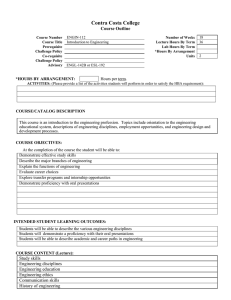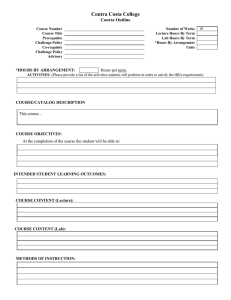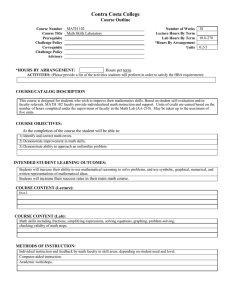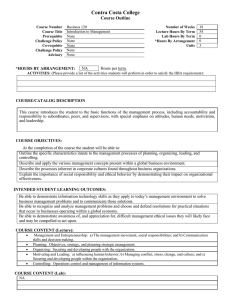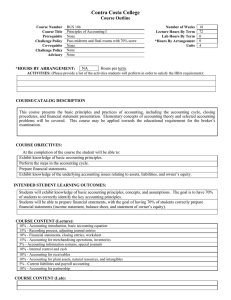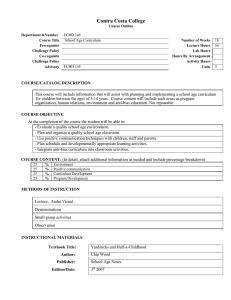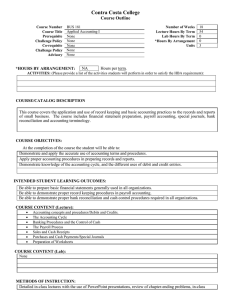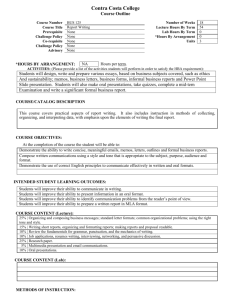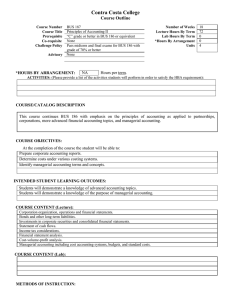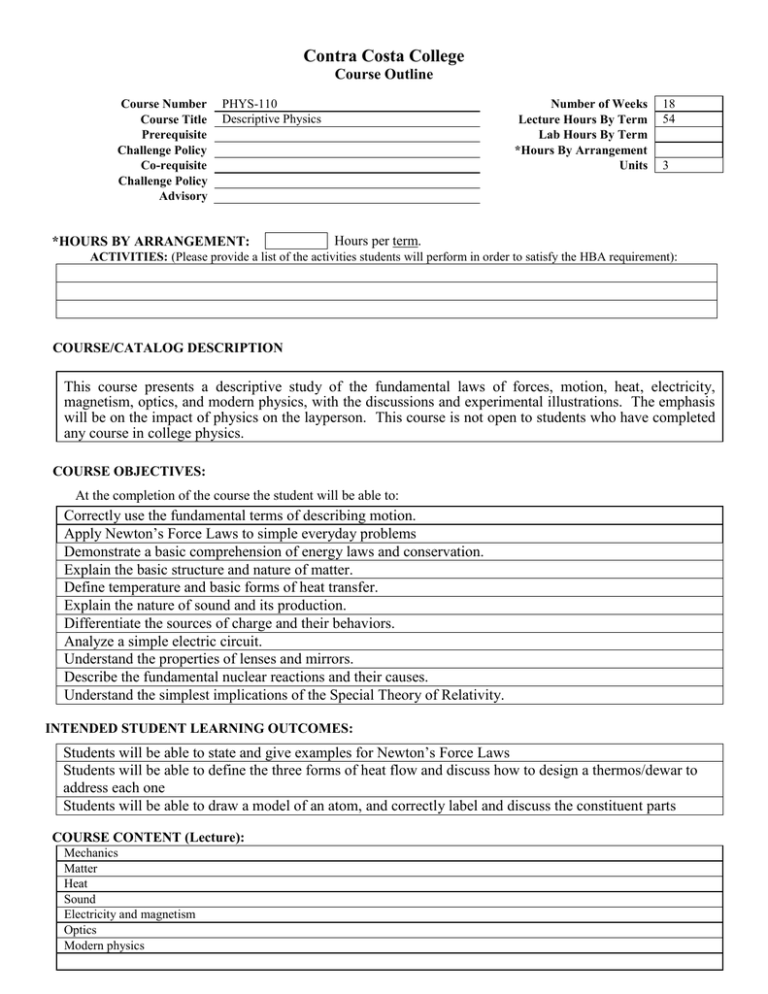
Contra Costa College
Course Outline
Course Number
Course Title
Prerequisite
Challenge Policy
Co-requisite
Challenge Policy
Advisory
PHYS-110
Descriptive Physics
*HOURS BY ARRANGEMENT:
Number of Weeks
Lecture Hours By Term
Lab Hours By Term
*Hours By Arrangement
Units
18
54
3
Hours per term.
ACTIVITIES: (Please provide a list of the activities students will perform in order to satisfy the HBA requirement):
COURSE/CATALOG DESCRIPTION
This course presents a descriptive study of the fundamental laws of forces, motion, heat, electricity,
magnetism, optics, and modern physics, with the discussions and experimental illustrations. The emphasis
will be on the impact of physics on the layperson. This course is not open to students who have completed
any course in college physics.
COURSE OBJECTIVES:
At the completion of the course the student will be able to:
Correctly use the fundamental terms of describing motion.
Apply Newton’s Force Laws to simple everyday problems
Demonstrate a basic comprehension of energy laws and conservation.
Explain the basic structure and nature of matter.
Define temperature and basic forms of heat transfer.
Explain the nature of sound and its production.
Differentiate the sources of charge and their behaviors.
Analyze a simple electric circuit.
Understand the properties of lenses and mirrors.
Describe the fundamental nuclear reactions and their causes.
Understand the simplest implications of the Special Theory of Relativity.
INTENDED STUDENT LEARNING OUTCOMES:
Students will be able to state and give examples for Newton’s Force Laws
Students will be able to define the three forms of heat flow and discuss how to design a thermos/dewar to
address each one
Students will be able to draw a model of an atom, and correctly label and discuss the constituent parts
COURSE CONTENT (Lecture):
Mechanics
Matter
Heat
Sound
Electricity and magnetism
Optics
Modern physics
COURSE CONTENT (Lab):
METHODS OF INSTRUCTION:
Lecture with demonstrations
Classroom discussions
INSTRUCTIONAL MATERIALS:
NOTE: To be UC/CSU transferable, the text must be dated within the last 7 years OR a statement of justification for a text beyond the
last 7 years must be included.
Textbook Title:
Author:
Publisher:
Edition/Date:
Justification Statement:
Textbook Reading Level:
Conceptual Physics
Paul G. Hewitt
Pearson Addison-Wesley
11th Edition / Copyright 2010
(For textbook beyond 7 years)
Lab Manual Title
Author:
Publisher:
Edition/Date:
OUTSIDE OF CLASS WEEKLY ASSIGNMENTS:
Title 5, section 55002.5 establishes that a range of 48 -54hours of lecture, study, or lab work is required for one unit of credit.
For each hour of lecture, students should be required to spend an additional two hours of study outside of class to earn one
unit of credit.
Title 5, section 55002(a) 2F establishes that coursework calls for critical thinking and the understanding and application of concepts
determined by the curriculum committee to be at college level.
For degree applicable courses: List one example of critical thinking homework
Outside of Class Weekly Assignments
Hours per week
Weekly Reading Assignments (Include detailed assignment below, if applicable)
3
Chapter 4, Newton’s Second Law of Motion, pages 58-66
Weekly Writing Assignments (Include detailed assignment below, if applicable)
3
Chapter 4, questions 6, 10, 11, 19, 23, 24, and 29, exercises 1, 6, 14, 19, 26, 33, and 35
Critical thinking homework example:
Given a converging lens of focal length 5.6 cm and an upright object at 10.0 cm in front of the lens find the location
and orientation of the image. Is this image real or virtual?
Weekly Math Problems (Include detailed assignment below, if applicable)
Lab or Software Application Assignments (Include detailed assignment below, if applicable)
Other Performance Assignments (Include detailed assignment below, if applicable)
STUDENT EVALUATION: (Show percentage breakdown for evaluation instruments)
Title 5, section 55002 (a) 2A establishes that the grade is based on demonstrated proficiency in subject matter and the ability to
demonstrate that proficiency.
For degree applicable courses: Course requires essay writing, or, in courses where the curriculum committee deems them
to be appropriate, by problem solving exercises, or skills demonstrations by students.
%
Essay
35
65
%
Computation or Non-computational Problem Solving Skills
Homework
Skills Demonstration
%
Objective Examinations
%
Other (describe)
%
%
%
GRADING POLICY: (Choose LG, P/NP, or SC)
Letter Grade
90% - 100% = A
80% - 89% = B
70% - 79% = C
60% - 69% = D
Below 60% = F
Pass / No Pass
70% and above = Pass
Below 70% = No Pass
X
Student Choice
90% - 100% = A
80% - 89% = B
70% - 79% = C
60% - 69% = D
Below 60% = F
Percentages vary from
instructor to instructor
Or
70% and above = Pass
Below 70% = No Pass
Prepared by: Jon Celesia and Mark Wong
Date: Spring 2015
Revised form 09/14

